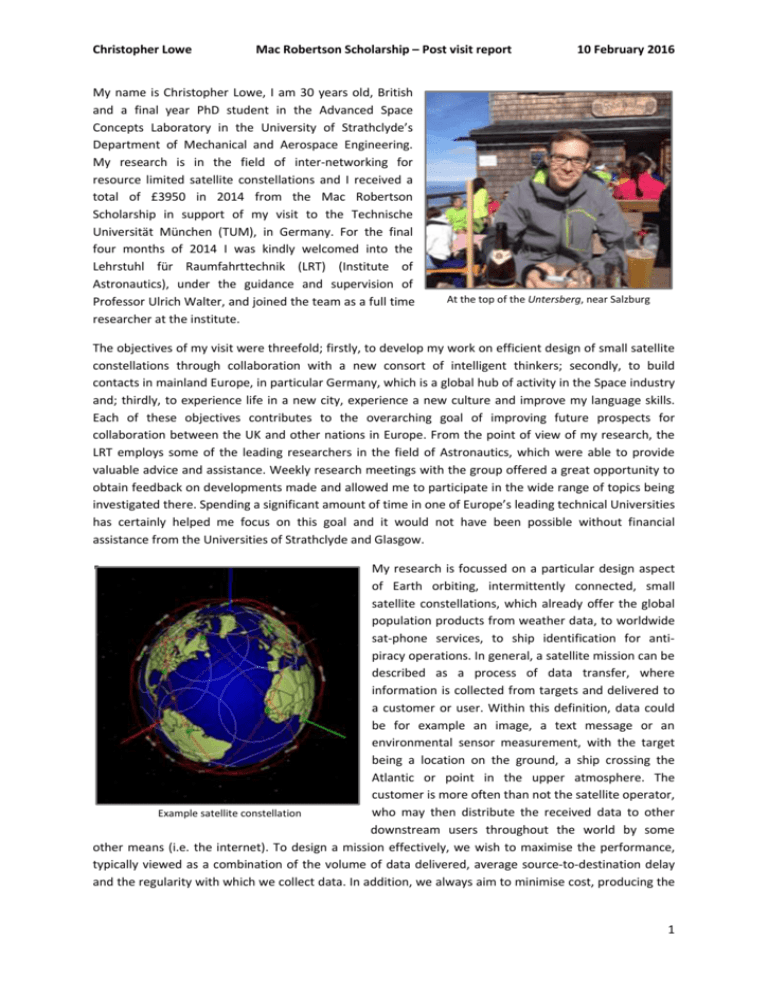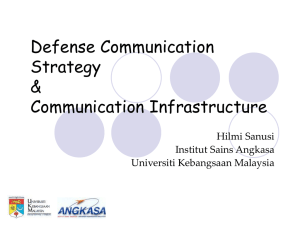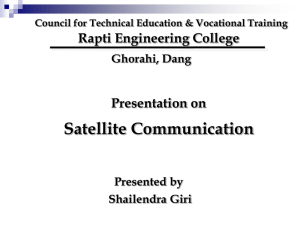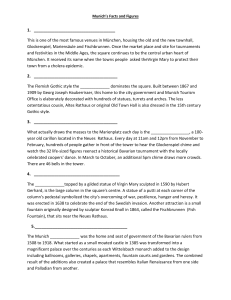Christopher Lowe - University of Glasgow
advertisement

Christopher Lowe Mac Robertson Scholarship – Post visit report My name is Christopher Lowe, I am 30 years old, British and a final year PhD student in the Advanced Space Concepts Laboratory in the University of Strathclyde’s Department of Mechanical and Aerospace Engineering. My research is in the field of inter-networking for resource limited satellite constellations and I received a total of £3950 in 2014 from the Mac Robertson Scholarship in support of my visit to the Technische Universität München (TUM), in Germany. For the final four months of 2014 I was kindly welcomed into the Lehrstuhl für Raumfahrttechnik (LRT) (Institute of Astronautics), under the guidance and supervision of Professor Ulrich Walter, and joined the team as a full time researcher at the institute. 10 February 2016 At the top of the Untersberg, near Salzburg The objectives of my visit were threefold; firstly, to develop my work on efficient design of small satellite constellations through collaboration with a new consort of intelligent thinkers; secondly, to build contacts in mainland Europe, in particular Germany, which is a global hub of activity in the Space industry and; thirdly, to experience life in a new city, experience a new culture and improve my language skills. Each of these objectives contributes to the overarching goal of improving future prospects for collaboration between the UK and other nations in Europe. From the point of view of my research, the LRT employs some of the leading researchers in the field of Astronautics, which were able to provide valuable advice and assistance. Weekly research meetings with the group offered a great opportunity to obtain feedback on developments made and allowed me to participate in the wide range of topics being investigated there. Spending a significant amount of time in one of Europe’s leading technical Universities has certainly helped me focus on this goal and it would not have been possible without financial assistance from the Universities of Strathclyde and Glasgow. My research is focussed on a particular design aspect of Earth orbiting, intermittently connected, small satellite constellations, which already offer the global population products from weather data, to worldwide sat-phone services, to ship identification for antipiracy operations. In general, a satellite mission can be described as a process of data transfer, where information is collected from targets and delivered to a customer or user. Within this definition, data could be for example an image, a text message or an environmental sensor measurement, with the target being a location on the ground, a ship crossing the Atlantic or point in the upper atmosphere. The customer is more often than not the satellite operator, who may then distribute the received data to other Example satellite constellation downstream users throughout the world by some other means (i.e. the internet). To design a mission effectively, we wish to maximise the performance, typically viewed as a combination of the volume of data delivered, average source-to-destination delay and the regularity with which we collect data. In addition, we always aim to minimise cost, producing the 1 Christopher Lowe Mac Robertson Scholarship – Post visit report 10 February 2016 characteristic cost vs. performance trade-off. A high performance can be achieved through intelligent placement of satellites into specific orbits, selection of suitable ground stations (with which the satellites communicate) and careful routing of data through the network. It is this final metric which is the focus of my work and I aim to develop novel routing algorithms specific to the performance of intermittently connected satellite networks. During my time in Germany, I developed software models to simulate satellite networks, which captured the respective flow of data from the source to destination, incorporating routing schemes based on graph-theoretical methods such as a modified Dijkstra’s shortest path algorithm. This approach can be applied to find the fastest journey, when moving between neighbouring satellites, in order to reach the destination as quickly as possible. Important to consider however, is that since the networks being considered here are generally not fully connected, routing methods for internet-type systems will not work. Instead, a store-carry-forward approach must be taken, which has received significantly less attention as an area of research. Furthermore, satellite networks are special in that their motion is highly deterministic, meaning certain methods that do not work for such things as human-social networks, can be applied successfully. The models I developed have since been applied to aid in the design of a medium-sized (20-30) satellite constellation to provide micro-wave measurements required for severe weather forecasting. This system would offer better global revisit times with shorter delay, than currently possible, which would support the capable network of satellites already in orbit. Work is still on-going to develop these models further, incorporating resource limitations, such as memory storage and energy, into the routing decision-making process. These limitations are a real problem for all satellites, but especially so on small- and nano-satellites, upon which our models are based. In addition to my own research, I became an active member of the student group, Wissenschaftliche Arbeitsgemeinschaft für Raketentechnik und Raumfahrt (WARR), and took part in the development of their 2nd Nanosatellite, the Munich Orbital Verification Experiment 2 (MOVE-2). I was also able to participate in a visit to Stuttgart University to meet with MOVE-2 team at Stuttgart University with The Flying Laptop satellite the team building the Flying Laptop satellite (image). I hope this experience, and the contacts made within the MOVE team, will offer a fantastic group of contacts for the future. The Scottish CubeSat industry is expanding rapidly, so having potential collaborators with a significant amount of experience in the field can only be positive. A bi-weekly journal club offered the chance for the whole group to discuss different elements of a recently published journal paper, with the aim of improving our academic writing skills as well as becoming effective reviewers. During my time at the University I enjoyed a very interactive office space with two other PhD researchers, who offered endless advice on German grammar and general life in Munich. With a door looking out onto the kitchen, which accommodated the four (yes, four) different coffee machines, our office maintained its reputation as a social hub allowing me to get to know most of the researchers well. Regarding coffee, it was clear from an early stage that this would become a significant feature of my stay and it soon became clear why Munich is often referred to as Italy’s most northerly city. Lunch was the other main 2 Christopher Lowe Mac Robertson Scholarship – Post visit report 10 February 2016 event each day, for which a number of the laboratory members and I typically took the short journey over to a nearby canteen at the Max Plank Institute for Plasma Physics. Outside of the work place, I made many new friends in and around Munich, who introduced me to the city and joined me in creating numerous unforgettable experiences, such as Oktoberfest, a day at Munich Zoo and trips to the Alps. I did my fair share of sightseeing in and around Munich, which is a stunning city with beautiful architecture and a rich history. The old town hall (Altes Rathaus) and four main “gates” into the city centre were a particular highlight, which date back to the Middle-ages, and really express the grandeur of that time. Near to Munich, hidden in the Alps, is one of the most famous landmarks of Bavaria, King Ludwig’s Schloss Neuschwanstein, on which Walt Disney based the design of Sleeping Beauty’s Castle. Making new friends at the Oktoberfest The Mac Robertson scholarship has allowed me to conduct a research placement that has helped consolidate research that has been on going in Glasgow for many years and enabled me to obtain fresh ideas from external researchers in similar fields. This type of collaboration is worth an enormous amount and I consider my experience at TUM one of the most beneficial I have had The view of Schloss Neuschwanstein in my career so far, from both a research and industrial point of view. Furthermore, having some time in a new environment provides a good opportunity to think with a clear head and I am confident this has helped me move forward with elements of my research which were perhaps stagnating. I will look back on my visit to Munich with fond memories and it is certainly a highlight of my post-graduate experience. I would urge anyone to take on the challenge of studying abroad, and am very thankful of the assistance provided through the Mac Robertson scholarship scheme. View of the Alps from the Klettersteig Höhenweg, near Munich 3









